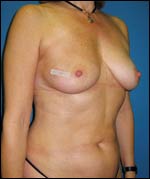 |
A review of this magazine and several others will reveal many exciting techniques to help you provide contemporary, high-quality results for your patients.
Less, however, is written and discussed regarding the finer points of the surgeon’s focus on patient care.
Chief among these are communication and detailed evaluation and planning.
COMMUNICATION
A friend of mine recently went to a card shop and ordered invitations to an event. He told the salesperson that he wanted a brown border on the invitation.
She replied that they only had black borders in stock.
My friend questioned further, “But can you do it?”
She responded, “Yes.”
Two weeks later, the invitations arrived and they had black borders.
He was furious. “But I told you I wanted brown!” he exclaimed.
She replied, “And I told you we only have black.”
At the time he placed his order, he assumed she was placing an order for brown-bordered invitations. Does anyone remember what happens when we assume?
Poor communication is not limited to the retail world. In medicine, the results can be much more dire.
In aesthetic surgery, poor communication often leads to the wrong surgery. This can result from a wrong patient, a wrong goal, or a wrong fit.
A “wrong” patient may be a poor candidate due to psychosocial reasons, unrealistic expectations, and/or overall health issues.
 |
A wrong goal can doom the endeavor from the start. It is important to determine what is the objectionable or distracting feature and how to address it to achieve mutual expectations.
A wrong fit can be due to a poor personality mesh or a different view of aesthetics.
In some respects, choosing to operate on someone is very much like going on a trip together. There will be intense, high-stakes interaction that will require cooperation and mutual understanding to achieve mutually satisfying results.
When you and a prospective patient bring differing visions of aesthetics to the table, neither view may be necessarily right or wrong. Only discussion, rapport, and review between patient and surgeon can reveal such variance.
You should do your utmost to provide the patient-to-be with honest examples of what could come from surgery—both physical and emotional results. In addition, patient expectations must be managed.
DETAILED EVALUATION AND PLANNING
Good planning takes time. There is no substitute for spending the time to determine if the patient is an appropriate candidate, what procedure is appropriate, and how that procedure should be carried out.
Also to be addressed are any medical issues regarding the patient’s health status, as well as his or her appropriateness for surgery.
You should decide if you want to take an optimistic approach or an efficiency tract.
The former involves an intense evaluation of the patient, with detailed planning toward surgery at the time of consultation.
In the latter case, you perform such an evaluation at a preoperative appointment after the patient has committed to the surgery.
|
See also “Hold That Patient” by Steven H. Dayan, MD, FACS, in the November 2007 issue of PSP. |
I find the optimistic method to be a more comfortable and natural approach.
Regardless of the choice, such evaluations and planning must be carried out prior to the day of surgery in order to properly determine the patient’s expectations and the appropriate method of meeting them.
While quality time is important, quantity does matter and cannot be avoided.
I propose that it is a much more efficient use of your time to spend as much time as needed to determine the patient’s expectations, and then do everything you reasonably can in order to meet them.
Scott R. Miller, MD, is an attending surgeon at Scripps Memorial Hospital in La Jolla, Calif, and a voluntary clinical instructor of plastic surgery at the University of California, San Diego. He can be reached at .




